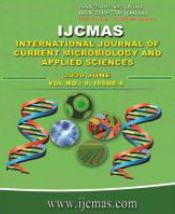


 National Academy of Agricultural Sciences (NAAS)
National Academy of Agricultural Sciences (NAAS)

|
PRINT ISSN : 2319-7692
Online ISSN : 2319-7706 Issues : 12 per year Publisher : Excellent Publishers Email : editorijcmas@gmail.com / submit@ijcmas.com Editor-in-chief: Dr.M.Prakash Index Copernicus ICV 2018: 95.39 NAAS RATING 2020: 5.38 |
CERES-Maize model calibrated for local conditions of Sabour has been used to evaluate the daily weather data (1985 to 2009) to the maize crop growth period. The procedure is to place the daily weather into the model up to the time the yield prediction is to be made and sequences of historical data after that time until the end of growing season to give yield estimates. A procedure that makes use of historical weather data and different sowing date with the CERES-Maize model was developed to arrive at a probable distribution of predicted yields. The lower temperature and more solar radiation in tassel emergence to dough stage, silk emergence to physiological maturity phase and lower maximum temperature are found favorable to contribute more in increasing the grain yields. The CERES- Maize model correlated for the genetic coefficient predicts the silking dates and physiological maturity very well. The kharif maize gave the highest grain yield of 3689 kg/ha in 2007 and the lowest of 2348 kg/ha in 2003. Among eight different sowing dates the lowest average grain yield was 3325 kg/ha for the last sowing date and the highest average grain yield was 3725 kg/ha in 2nd sowing date. The 25 percentiles were less than the mean grain yields and also 75 percentiles.
 |
 |
 |
 |
 |